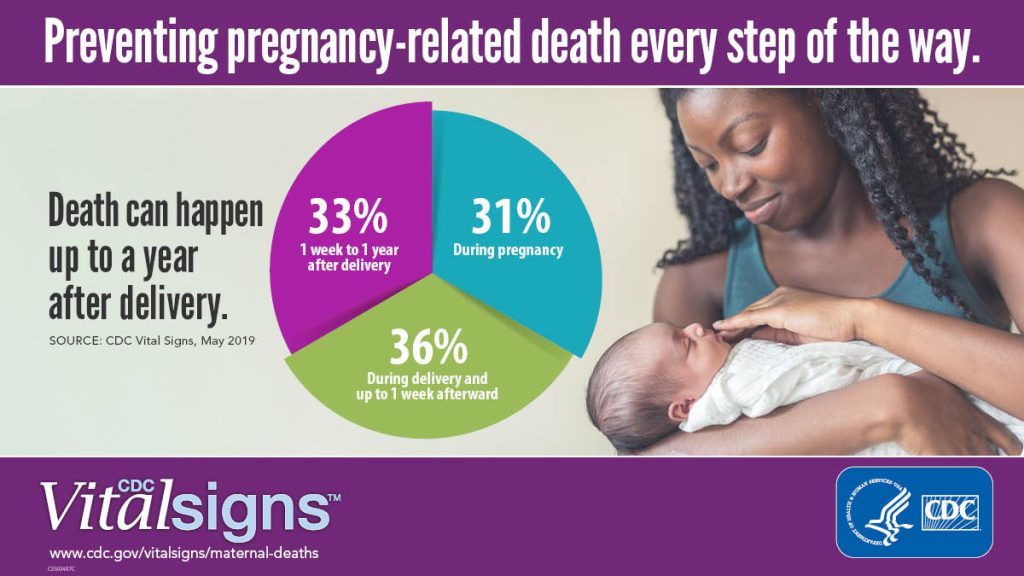 The latest report on maternal mortality in the US published in February by the Centers for Disease Control and Prevention (CDC) reveals that the country’s overall maternal death rate has risen yet again — this time by 18% from 2019 to 2020. The rate has increased by nearly 37% since 2018. In total, 861 women in 2020 died either during or within 42 days of the end of their pregnancy.
The latest report on maternal mortality in the US published in February by the Centers for Disease Control and Prevention (CDC) reveals that the country’s overall maternal death rate has risen yet again — this time by 18% from 2019 to 2020. The rate has increased by nearly 37% since 2018. In total, 861 women in 2020 died either during or within 42 days of the end of their pregnancy.
According to the agency, 31% of pregnancy-related deaths happen during pregnancy, 36% during labor and delivery, and 33% during the year after pregnancy. The data also shows that Black women are 3 times more likely to die and American Indian and Alaska Native women are 2 times more likely to die from pregnancy-related complications than Caucasian women.
Tragically, 2 out of 3 of these deaths can be prevented. Women’s health nurse practitioners now have a wealth of resources to help change these sobering outcomes via a new CDC website.
‘Hear Her’ campaign
The website is the latest addition to the CDC’s Hear Her campaign, initially launched in 2020. The campaign is designed to help pregnant or postpartum women, their families, and clinicians recognize when to seek medical care that can help to reduce preventable deaths. The new CDC website builds on that campaign by providing prevention tools and other educational materials for clinicians by specialty in multiple languages.
Clinical tools from trusted sources
Among the clinical tools featured on the site especially for women’s healthcare professionals (HCPs) are:
- Maternal Patient Safety Bundles developed by the former Council on Patient Safety in Women’s Health Care
- Maternal Early Warning Signs (MEWS) Protocols developed by the former Council on Patient Safety in Women’s Health Care
- Toolkit for Improving Perinatal Safety developed by the Agency for Healthcare Research and Quality (AHRQ) and
- Guide to Patient and Family Engagement in Hospital Quality and Safety also developed by the AHRQ.
The site is also rich in educational modules from trusted sources including:
- POST-BIRTH Warning Signs Education Program developed by the Association of Women’s Health, Obstetric and Neonatal Nurses (AWHONN)
- Back to Basics: Foundations for Mindful Care also developed AWHONN
- Eliminating Preventable Maternal Mortality and Morbidity from the American College of Obstetricians and Gynecologists (ACOG) and
- Maternal Cardiac Conditions: Addressing a Leading Cause of Pregnancy-Related Death, a recent webinar hosted ACOG.
Patient-targeted alerts and shareable materials
The site also equips providers with visually engaging, direct-to-patient communications tools. For example, a checklist developed by the Alliance for Innovation on Maternal Health alerts women to 15 urgent maternal warning signs and symptoms during pregnancy and during the year after delivery which require them to seek immediate medical help.
In addition, there are posters and handouts downloadable from the site in multiple languages, digital content to post and share across your practice’s social media channels, and videos spotlighting compelling personal stories from women of diverse backgrounds who experienced severe pregnancy-related complications.
Also available is a downloadable 1-page PDF “Conversation Guide and Palm Card for Families, Friends, and Partners,” intended for a patient’s support circle to help encourage their loved one to share when “something doesn’t feel right” and to support her to obtain the care and answers she may need.
Listening leads to trust
The site stresses how important it is for HCPs to find and take the time to forge a partnership with their patients because engaging them in their care can have a significant impact on health outcomes. Encourage patients to share any concerns they may have, the site counsels. Many women feel that their concerns during and after pregnancy are not heard. Even though healthcare settings are busy and time is limited, taking a few moments to actively listen to what is being said can make all the difference in better understanding your patient’s needs and providing quality care. Active listening involves receptive body language, it notes, and practicing empathy, repeating back questions or concerns, and asking clarifying questions ensure that you understand her concerns. Such active listening helps build trust with your patients through shared knowledge.
Finally, the site encourages providers to consider taking training on diversity, shared decision making, cultural competency, and implicit biases as these have each been studied and shown to be important components in addressingdisparities in healthcare and health outcomes.
Women’s health nurse practitioners have a unique opportunity to begin to building trust and a relationship with your patient early during prenatal visits. Your patient interactions can be lifesaving and help stem the upward trajectory of mothers at risk.
All of the CDC’s “Hear Her” resources and tools can be found at https://www.cdc.gov/hearher/index.html
The contents of this feature are not provided or reviewed by NPWH.

